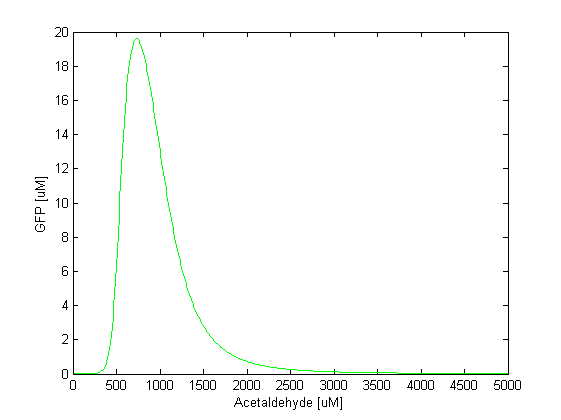Team:ETH Zurich/Achievements/Model Results
From 2011.igem.org
(Difference between revisions)
(→Feasibility Analysis) |
(→Feasibility Analysis) |
||
| Line 24: | Line 24: | ||
|[[File:AcABandpass.png|thumb|350px|center|'''Figure 1''': GFP vs. increasing acetaldehyde input (both in μM). The band appears when the acetaldehyde concentration is in the range of 500-1500 μM]] | |[[File:AcABandpass.png|thumb|350px|center|'''Figure 1''': GFP vs. increasing acetaldehyde input (both in μM). The band appears when the acetaldehyde concentration is in the range of 500-1500 μM]] | ||
| - | |{{:Team:ETH Zurich/Templates/Flash|name=flash_gfp_ss_sweep|url=/wiki/images/9/94/ETHZ-GFP_SS_Sweep.swf|width= | + | |{{:Team:ETH Zurich/Templates/Flash|name=flash_gfp_ss_sweep|url=/wiki/images/9/94/ETHZ-GFP_SS_Sweep.swf|width=280|widthP2=452|height=290|text='''Video 1: Steady state simulation sweep from 1 to 2500 mg/l acetaldehyde concentration in reservoir:''' 3D GFP concentration in mol/m<sup>3</sup>, 5 slices through the channel. Channel width: 2 mm, Channel length: 5 cm.}} |
| | | | ||
Revision as of 00:49, 22 September 2011
| Modeling Results |
| ||
| By modeling and simulating our system we verified that it can actually be implemented in reality. We checked its feasibility, drew some conclusions and decided on a most suitable channel design. | |||
Feasibility AnalysisWe verified that our initial idea works and that we can actually get a moving GFP band in the channel responding to different input acetaldehyde concentrations! In order our smoColi bacteria to start reporting acetaldehyde in the air (when GFP band appears at the begining of the channel), system should be supplied with around 44.05 mg/L acetaldehyde. In order for the band to be able to form at the very end of the channel, the input acetaldehyde concentration should be 2420 mg/L.
|
 "
"



